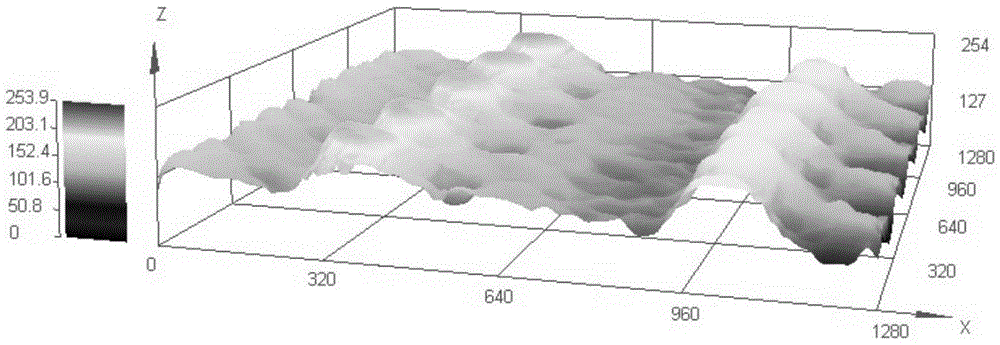Surface roughness reduction method of light-cured rapid prototype based on atomization technology
A surface roughness and light-curing technology, which is applied in the field of light-curing rapid prototyping, can solve problems such as waste of materials, mold cracking, and increased thermal stress, and achieve the effects of reducing roughness, saving costs, and ensuring dimensional accuracy
- Summary
- Abstract
- Description
- Claims
- Application Information
AI Technical Summary
Problems solved by technology
Method used
Image
Examples
Embodiment 1
[0035] A method for reducing the surface roughness of light-cured rapid prototypes based on atomization technology, comprising the following steps:
[0036] 1) Heating polyethylene wax emulsion
[0037] Select polyethylene wax emulsion as the raw material for flattening, heat the polyethylene wax emulsion in a heating range of 35°C to 40°C, the viscosity of the polyethylene wax emulsion decreases, and the viscosity of the polyethylene wax emulsion after heating is 6.0mPa.s to 9.0mPa.s. The viscosity is around 40mPa.s at room temperature, and the decrease in viscosity is beneficial to the subsequent ultrasonic atomization. If the heating temperature exceeds 40°C, the polyethylene wax emulsion will break and can no longer be used as a flat coating material;
[0038] Wherein, the polyethylene wax emulsion is prepared from polyethylene wax and sodium alkylbenzene sulfonate at a volume ratio of 3:7; the particle diameter of polyethylene wax particles in the polyethylene wax emulsio...
Embodiment 2
[0048] A method for reducing the surface roughness of light-cured rapid prototypes based on atomization technology, comprising the following steps:
[0049] 1) Warm palm wax emulsion
[0050] Select palm wax emulsion as the raw material for flattening, heat the palm wax emulsion at a heating range of 30°C to 40°C, the viscosity of the palm wax emulsion will decrease, after heating, the viscosity of the palm wax emulsion will be 6.0mPa. About 50mPa.s, the decrease in viscosity is conducive to the subsequent atomization. If the heating temperature exceeds 40°C, the palm wax emulsion will break and it can no longer be used as a flat coating material;
[0051] Wherein, the palm wax emulsion is prepared by preparing palm wax and gum arabic according to the volume ratio of 4:6; the particle diameter of the palm wax particles in the palm wax emulsion is 100-200nm.
[0052] 2) Ultra-high pressure atomization of palm wax emulsion
[0053] Adjust the pressure of the ultra-high-pressur...
Embodiment 3
[0060] A method for reducing the surface roughness of light-cured rapid prototypes based on atomization technology, comprising the following steps:
[0061] 1) Heating polytetrafluoroethylene wax and paraffin mixed wax emulsion
[0062] Select polytetrafluoroethylene wax and paraffin wax mixed wax emulsion as coating raw material, heat polytetrafluoroethylene wax and paraffin mixed wax emulsion, heating range 30 ℃ ~ 40 ℃, the viscosity of polytetrafluoroethylene wax and paraffin mixed wax emulsion decreases, After heating, the viscosity of polytetrafluoroethylene wax and paraffin mixed wax emulsion is 6.0mPa.s ~ 9.0mPa.s, and the viscosity is about 45mPa.s at room temperature. Demulsification occurs and can no longer be used as a flattening material;
[0063] Wherein, the volume ratio of polytetrafluoroethylene wax and paraffin wax in polytetrafluoroethylene wax and paraffin wax emulsion is 1:1, polytetrafluoroethylene wax and paraffin wax emulsion are wax (polytetrafluoroeth...
PUM
| Property | Measurement | Unit |
|---|---|---|
| viscosity | aaaaa | aaaaa |
| particle diameter | aaaaa | aaaaa |
| thickness | aaaaa | aaaaa |
Abstract
Description
Claims
Application Information
 Login to View More
Login to View More - R&D
- Intellectual Property
- Life Sciences
- Materials
- Tech Scout
- Unparalleled Data Quality
- Higher Quality Content
- 60% Fewer Hallucinations
Browse by: Latest US Patents, China's latest patents, Technical Efficacy Thesaurus, Application Domain, Technology Topic, Popular Technical Reports.
© 2025 PatSnap. All rights reserved.Legal|Privacy policy|Modern Slavery Act Transparency Statement|Sitemap|About US| Contact US: help@patsnap.com


